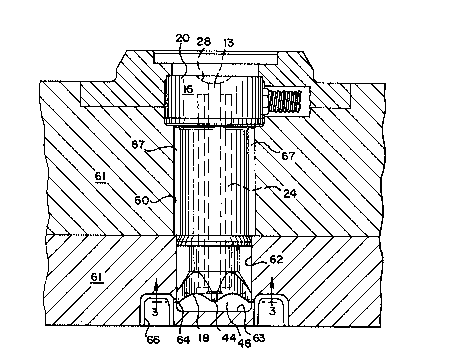Some of the information on this Web page has been provided by external sources. The Government of Canada is not responsible for the accuracy, reliability or currency of the information supplied by external sources. Users wishing to rely upon this information should consult directly with the source of the information. Content provided by external sources is not subject to official languages, privacy and accessibility requirements.
Any discrepancies in the text and image of the Claims and Abstract are due to differing posting times. Text of the Claims and Abstract are posted:
| (12) Patent: | (11) CA 2004683 |
|---|---|
| (54) English Title: | MULTI-GATE MOLDING HEATER ASSEMBLY |
| (54) French Title: | ELEMENTS CHAUFFANTS POUR MOULE D'INJECTION MULTICANAL |
| Status: | Expired and beyond the Period of Reversal |
| (51) International Patent Classification (IPC): |
|
|---|---|
| (72) Inventors : |
|
| (73) Owners : |
|
| (71) Applicants : | |
| (74) Agent: | OSLER, HOSKIN & HARCOURT LLP |
| (74) Associate agent: | |
| (45) Issued: | 1994-04-05 |
| (22) Filed Date: | 1989-12-06 |
| (41) Open to Public Inspection: | 1990-09-01 |
| Examination requested: | 1989-12-06 |
| Availability of licence: | N/A |
| Dedicated to the Public: | N/A |
| (25) Language of filing: | English |
| Patent Cooperation Treaty (PCT): | No |
|---|
| (30) Application Priority Data: | ||||||
|---|---|---|---|---|---|---|
|
MULTI-GATE HEATER ASSEMBLY
ABSTRACT OF THE DISCLOSURE
An injection molding heater assembly for use in
multi-gate injection molding includes an elongate heating
member extending within a mold bore in heating communication
with the mold bore mold gates. The heating member has an
elongate body portion extending between an inlet portion and an
outlet portion. A melt injection passage extends through the
inlet portion to convey melt along the body portion to an
enlarged portion having a nozzle face. Extending down from the
nozzle face are a series of members which include gate tips at
their lower ends. Radial channels present in the gate tips
serve as extensions to the mold bore mold gates. The gate tips
are peripherally spaced apart around the nozzle face and define
a recess between the gate tips, the nozzle face and the mold
bore for initially injected melt to accumulate in and solidify
to form a melt plug. The melt plug serves to insulate the
subsequently injected melt from the mold bore and maintain the
injected melt in a third condition.
Note: Claims are shown in the official language in which they were submitted.
Note: Descriptions are shown in the official language in which they were submitted.

2024-08-01:As part of the Next Generation Patents (NGP) transition, the Canadian Patents Database (CPD) now contains a more detailed Event History, which replicates the Event Log of our new back-office solution.
Please note that "Inactive:" events refers to events no longer in use in our new back-office solution.
For a clearer understanding of the status of the application/patent presented on this page, the site Disclaimer , as well as the definitions for Patent , Event History , Maintenance Fee and Payment History should be consulted.
| Description | Date |
|---|---|
| Time Limit for Reversal Expired | 2007-12-06 |
| Letter Sent | 2006-12-06 |
| Inactive: IPC from MCD | 2006-03-11 |
| Inactive: IPC from MCD | 2006-03-11 |
| Grant by Issuance | 1994-04-05 |
| Application Published (Open to Public Inspection) | 1990-09-01 |
| All Requirements for Examination Determined Compliant | 1989-12-06 |
| Request for Examination Requirements Determined Compliant | 1989-12-06 |
There is no abandonment history.
| Fee Type | Anniversary Year | Due Date | Paid Date |
|---|---|---|---|
| MF (patent, 8th anniv.) - small | 1997-12-08 | 1997-11-04 | |
| MF (patent, 9th anniv.) - small | 1998-12-07 | 1998-11-03 | |
| MF (patent, 10th anniv.) - small | 1999-12-06 | 1999-11-04 | |
| MF (patent, 11th anniv.) - small | 2000-12-06 | 2000-11-03 | |
| MF (patent, 12th anniv.) - small | 2001-12-06 | 2001-11-02 | |
| MF (patent, 13th anniv.) - small | 2002-12-06 | 2002-11-04 | |
| MF (patent, 14th anniv.) - small | 2003-12-08 | 2003-11-05 | |
| MF (patent, 15th anniv.) - small | 2004-12-06 | 2004-12-06 | |
| MF (patent, 16th anniv.) - small | 2005-12-06 | 2005-11-14 | |
| 2005-11-14 |
Note: Records showing the ownership history in alphabetical order.
| Current Owners on Record |
|---|
| PANOS TRAKAS |
| Past Owners on Record |
|---|
| None |